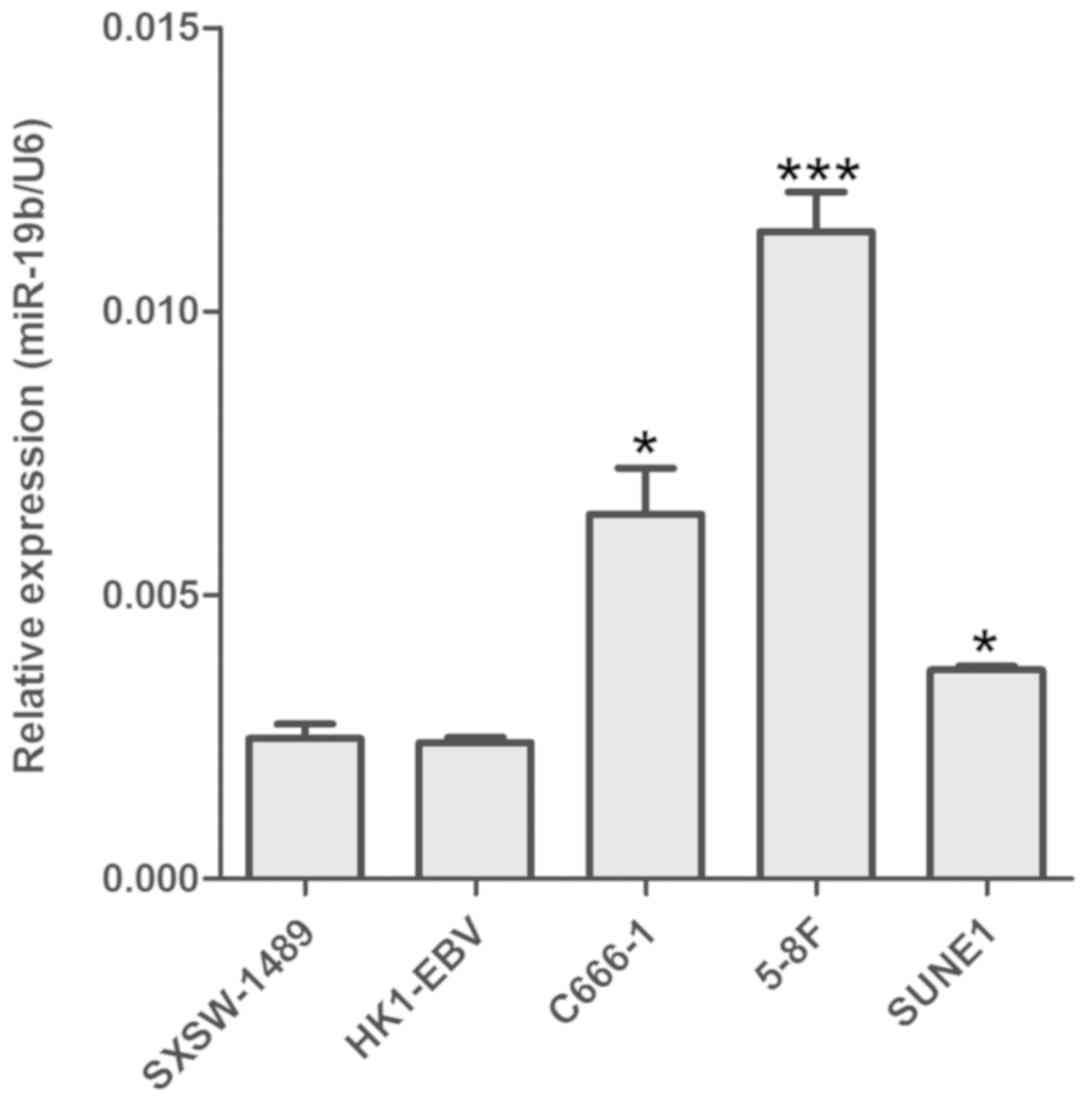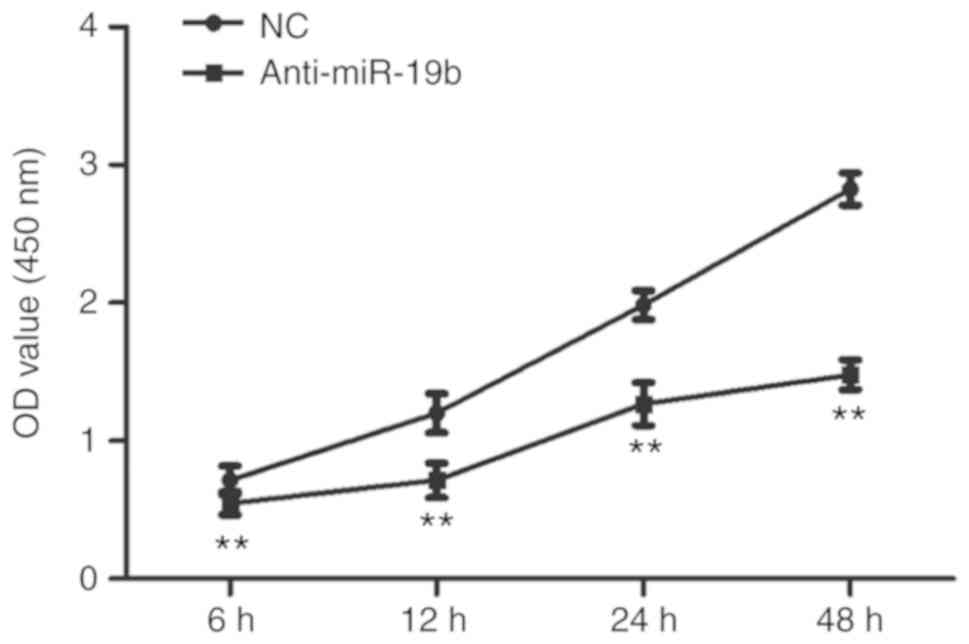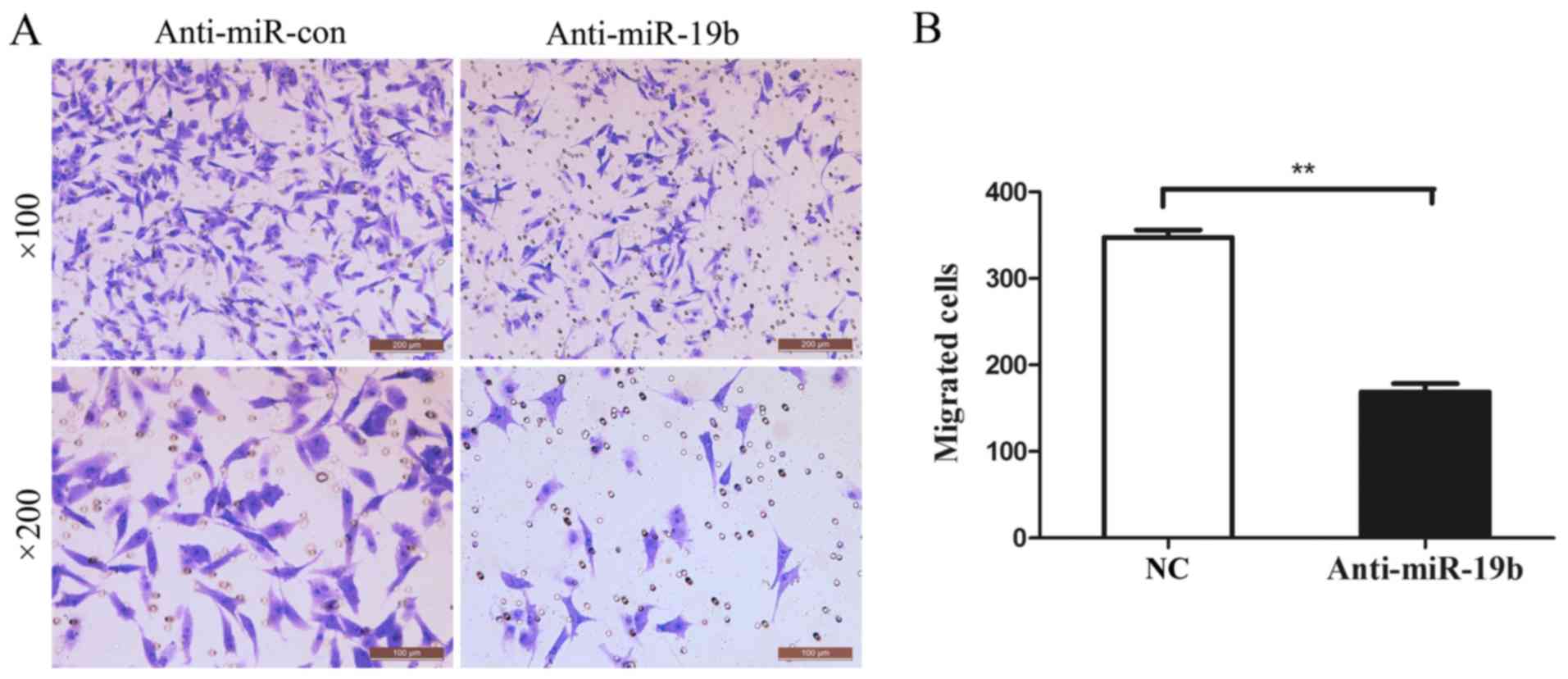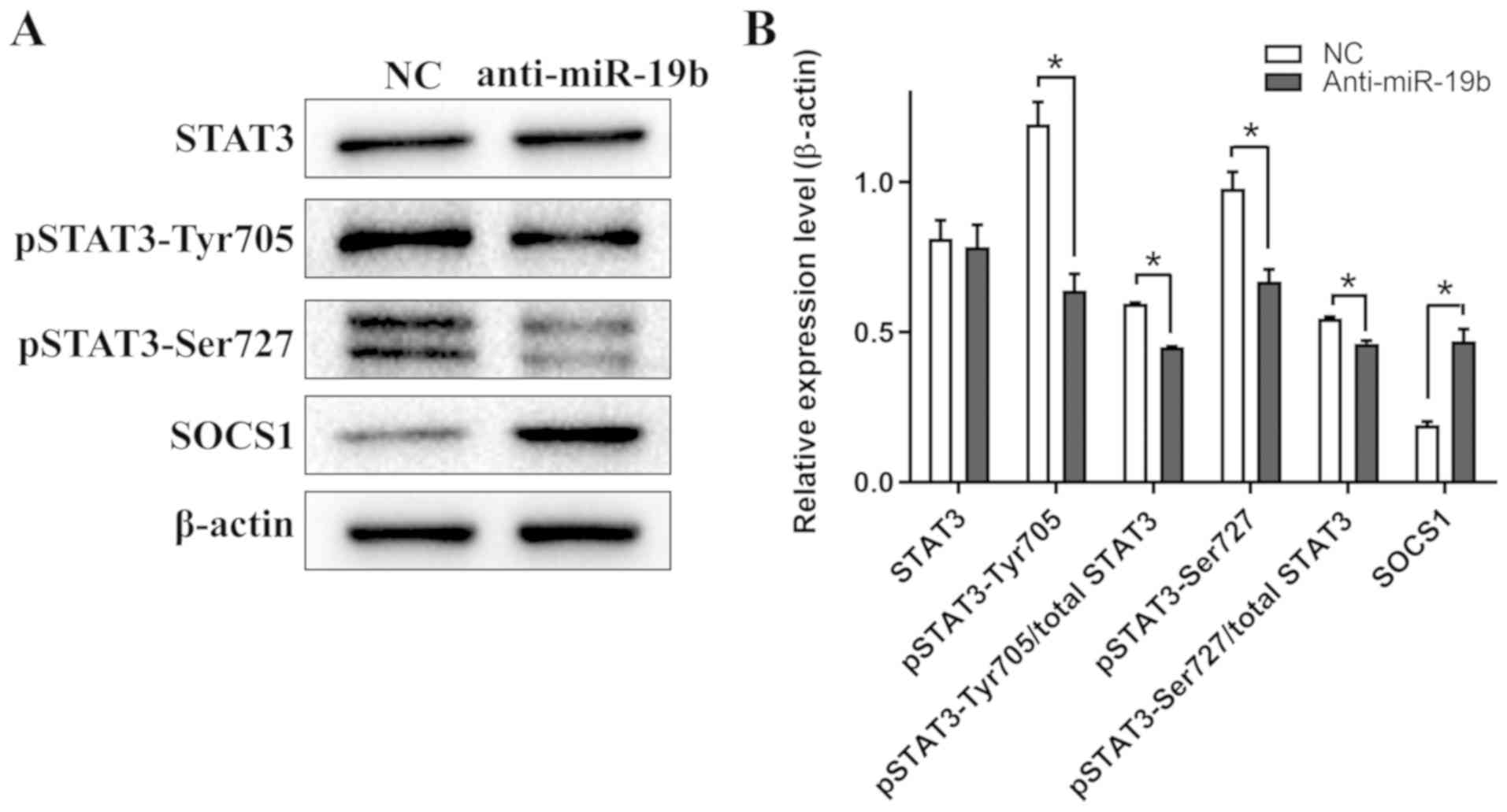|
1
|
Chua MLK, Wee JTS, Hui EP and Chan ATC:
Nasopharyngeal carcinoma. Lancet. 387:1012–1024. 2016. View Article : Google Scholar : PubMed/NCBI
|
|
2
|
Prawira A, Oosting SF, Chen TW, Delos
Santos KA, Saluja R, Wang L, Siu LL, Chan KKW and Hansen AR:
Systemic therapies for recurrent or metastatic nasopharyngeal
carcinoma: A systematic review. Br J Cancer. 117:1743–1752. 2017.
View Article : Google Scholar : PubMed/NCBI
|
|
3
|
Ambros V: The functions of animal
microRNAs. Nature. 431:350–355. 2004. View Article : Google Scholar : PubMed/NCBI
|
|
4
|
Jansson MD and Lund AH: MicroRNA and
cancer. Mol Oncol. 6:590–610. 2012. View Article : Google Scholar : PubMed/NCBI
|
|
5
|
Chen HC, Chen GH, Chen YH, Liao WL, Liu
CY, Chang KP, Chang YS and Chen SJ: MicroRNA deregulation and
pathway alterations in nasopharyngeal carcinoma. Br J Cancer.
100:1002–1011. 2009. View Article : Google Scholar : PubMed/NCBI
|
|
6
|
Chen Y, Gao DY and Huang L: In vivo
delivery of miRNAs for cancer therapy: Challenges and strategies.
Adv Drug Deliv Rev. 81:128–141. 2015. View Article : Google Scholar : PubMed/NCBI
|
|
7
|
Braicu C, Calin GA and Berindan-Neagoe I:
MicroRNAs and cancer therapy-from bystanders to major players. Curr
Med Chem. 20:3561–3573. 2013. View Article : Google Scholar : PubMed/NCBI
|
|
8
|
Li J, Yang S, Yan W, Yang J, Qin YJ, Lin
XL, Xie RY, Wang SC, Jin W, Gao F, et al: MicroRNA-19 triggers
epithelial-mesenchymal transition of lung cancer cells accompanied
by growth inhibition. Lab Invest. 95:1056–1070. 2015. View Article : Google Scholar : PubMed/NCBI
|
|
9
|
Li C, Zhang J, Ma Z, Zhang F and Yu W:
miR-19b serves as a prognostic biomarker of breast cancer and
promotes tumor progression through PI3K/AKT signaling pathway. Onco
Targets Ther. 11:4087–4095. 2018. View Article : Google Scholar : PubMed/NCBI
|
|
10
|
Vij N, Sharma A, Thakkar M, Sinha S and
Mohan RR: PDGF-driven proliferation, migration, and IL8 chemokine
secretion in human corneal fibroblasts involve JAK2-STAT3 signaling
pathway. Mol Vis. 14:1020–1027. 2008.PubMed/NCBI
|
|
11
|
Ma F, Wang Z, Wang J, Liu X and Hu C:
MicroRNA-19a promotes nasopharyngeal carcinoma by targeting
transforming growth factor β receptor 2. Exp Ther Med.
14:1419–1426. 2017. View Article : Google Scholar : PubMed/NCBI
|
|
12
|
Hsu CY, Yi YH, Chang KP, Chang YS, Chen SJ
and Chen HC: The epstein-barr virus-encoded MicroRNA MiR-BART9
Promotes Tumor Metastasis by Targeting E-Cadherin in nasopharyngeal
carcinoma. PLoS Pathog. 10:e10039742014. View Article : Google Scholar : PubMed/NCBI
|
|
13
|
Lin TY, Chen Y, Jia JS, Zhou C, Lian M,
Wen YT, Li XY, Chen HW, Lin XL, Zhang XL, et al: Loss of Cirbp
expression is correlated with the malignant progression and poor
prognosis in nasopharyngeal carcinoma. Cancer Manag Res.
11:6959–6969. 2019. View Article : Google Scholar : PubMed/NCBI
|
|
14
|
Zhao M, Luo R, Liu Y, Gao L, Fu Z, Fu Q,
Luo X, Chen Y, Deng X, Liang Z, et al: MiR-3188 regulates
nasopharyngeal carcinoma proliferation and chemosensitivity through
a FOXO1-modulated positive feedback loop with
mTOR-p-PI3K/AKT-c-JUN. Nat Commun. 7:11309–11322. 2016. View Article : Google Scholar : PubMed/NCBI
|
|
15
|
Li X, Zhao Z, Zhang X, Yang S, Lin X, Yang
X, Lin X, Shi J, Wang S, Zhao W, et al: Klf4 reduces stemness
phenotype, triggers mesenchymal-epithelial transition (MET)-like
molecular changes, and prevents tumor progression in nasopharygeal
carcinoma. Oncotarget. 8:93924–93941. 2017. View Article : Google Scholar : PubMed/NCBI
|
|
16
|
Xiao K, Yu Z, Li X, Li X, Tang K, Tu C, Qi
P, Liao Q, Chen P, Zeng Z, et al: Genome-wide analysis of
epstein-barr virus (EBV) integration and strain in C666-1 and raji
cells. J Cancer. 7:214–224. 2016. View Article : Google Scholar : PubMed/NCBI
|
|
17
|
Davey GM, Heath WR and Starr R: SOCS1: A
potent and multifaceted regulator of cytokines and cell-mediated
inflammation. Tissue Antigens. 67:1–9. 2006. View Article : Google Scholar : PubMed/NCBI
|
|
18
|
Liu M, Yang R, Urrehman U, Ye C, Yan X,
Cui S, Hong Y, Gu Y, Liu Y, Zhao C, et al: MiR-19b suppresses PTPRG
to promote breast tumorigenesis. Oncotarget. 7:64100–64108. 2016.
View Article : Google Scholar : PubMed/NCBI
|
|
19
|
Wang H, Xiong M, Hu Y, Sun Y and Ma Q:
MicroRNA-19b inhibits proliferation of gastric cancer cells by
targeting B-cell CLL/lymphoma 3. Oncol Rep. 36:2079–2086. 2016.
View Article : Google Scholar : PubMed/NCBI
|
|
20
|
Li X, Wang FS, Wu ZY, Lin JL, Lan WB and
Lin JH: MicroRNA-19b targets Mfn1 to inhibit Mfn1-induced apoptosis
in osteosarcoma cells. Neoplasma. 61:265–273. 2014. View Article : Google Scholar : PubMed/NCBI
|
|
21
|
Fan Y, Yin S, Hao Y, Yang J, Zhang H, Sun
C, Ma M, Chang Q and Xi JJ: miR-19b promotes tumor growth and
metastasis via targeting TP53. RNA. 20:765–772. 2014. View Article : Google Scholar : PubMed/NCBI
|
|
22
|
Luo Z, Dai Y, Zhang L, Jiang C, Li Z, Yang
J, McCarthy JB, She X, Zhang W, Ma J, et al: MiR-18a promotes
malignant progression by impairing microRNA biogenesis in
nasopharyngeal carcinoma. Carcinogenesis. 34:415–425. 2013.
View Article : Google Scholar : PubMed/NCBI
|
|
23
|
Cheng GZ, Zhang W, Sun M, Wang Q, Coppola
D, Mansour M, Xu LM, Costanzo C, Cheng JQ and Wang LH: Twist is
transcriptionally induced by activation of STAT3 and mediates STAT3
oncogenic function. J Biol Chem. 283:14665–14673. 2008. View Article : Google Scholar : PubMed/NCBI
|
|
24
|
Ferguson SD, Srinivasan VM and Heimberger
AB: The role of STAT3 in tumor-mediated immune suppression. J
Neurooncol. 123:385–394. 2015. View Article : Google Scholar : PubMed/NCBI
|
|
25
|
Teng Y, Ross JL and Cowell JK: The
involvement of JAK-STAT3 in cell motility, invasion, and
metastasis. JAKSTAT. 3:e280862014.PubMed/NCBI
|
|
26
|
Lo AK, Lo KW, Tsao SW, Wong HL, Hui JW, To
KF, Hayward DS, Chui YL, Lau YL, Takada K and Huang DP:
Epstein-barr virus infection alters cellular signal cascades in
human nasopharyngeal epithelial cells. Neoplasia. 8:173–180. 2006.
View Article : Google Scholar : PubMed/NCBI
|
|
27
|
Ho Y, Tsao SW, Zeng M and Lui VW: STAT3 as
a therapeutic target for Epstein-Barr virus (EBV): Associated
nasopharyngeal carcinoma. Cancer Lett. 330:141–149. 2013.
View Article : Google Scholar : PubMed/NCBI
|
|
28
|
Naka T, Narazaki M, Hirata M, Matsumoto T,
Minamoto S, Aono A, Nishimoto N, Kajita T, Taga T, Yoshizaki K, et
al: Structure and functionof a new STAT-induced STAT inhibitor.
Nature. 387:924–929. 1997. View
Article : Google Scholar : PubMed/NCBI
|
|
29
|
Hamanaka I, Saito Y, Yasukawa H, Kishimoto
I, Kuwahara K, Miyamoto Y, Harada M, Ogawa E, Kajiyama N, Takahashi
N, et al: Induction of JAB/SOCS-1/SSI-1 and CIS3/SOCS-3/SSI-3 is
involved in gp130 resistance in cardiovascular system in rat
treated with cardiotrophin-1 in vivo. Circ Res. 88:727–732. 2001.
View Article : Google Scholar : PubMed/NCBI
|
|
30
|
Ben-Zvi T, Yayon A, Gertler A and
Monsonego-Ornan E: Suppressors of cytokine signaling (SOCS) 1 and
SOCS3 interact with and modulate fibroblast growth factor receptor
signaling. J Cell Sci. 2:380–387. 2006. View Article : Google Scholar
|
|
31
|
Mignacca L, Saint-Germain E, Benoit A,
Bourdeau V, Moro A and Ferbeyre G: Sponges against miR-19 and
miR-155 reactivate the p53-Socs1 axis in hematopoietic cancers.
Cytokine. 82:80–86. 2016. View Article : Google Scholar : PubMed/NCBI
|
|
32
|
Huang TQ, Willis MS and Meissner G:
IL-6/STAT3 signaling in mice with dysfunctional type-2 ryanodine
receptor. JAKSTAT. 4:e11583792016.PubMed/NCBI
|
|
33
|
Wang Y, van Boxel-Dezaire AH, Cheon H,
Yang J and Stark GR: STAT3 activation in response to IL-6 is
prolonged by the binding of IL-6 receptor to EGF receptor. Proc
Natl Acad Sci USA. 110:16975–16980. 2013. View Article : Google Scholar : PubMed/NCBI
|
|
34
|
Parys JB: The multifaceted STAT3: How a
transcription factor regulates Ca2+ signaling via a
degradative pathway. Cell Calcium. 76:137–139. 2018. View Article : Google Scholar : PubMed/NCBI
|
|
35
|
Yokogami K, Wakisaka S, Avruch J and
Reeves SA: Serine phosphorylation and maximal activation of STAT3
during CNTF signaling is mediated by the rapamycin target mTOR.
Curr Biol. 10:47–50. 2000. View Article : Google Scholar : PubMed/NCBI
|
|
36
|
Banerjee K and Resat H: Constitutive
activation of STAT3 in breast cancer cells: A review. Int J Cancer.
138:2570–2578. 2016. View Article : Google Scholar : PubMed/NCBI
|
|
37
|
Pardee AB: G1 events and regulation of
cell proliferation. Science. 246:603–608. 1989. View Article : Google Scholar : PubMed/NCBI
|
|
38
|
Lam M, Dubyak G, Chen L, Nuñez G, Miesfeld
RL and Distelhorst CW: Evidence that BCL-2 represses apoptosis by
regulating endoplasmic reticulum-associated Ca2+ fluxes. Proc Natl
Acad Sci USA. 91:6569–6573. 1994. View Article : Google Scholar : PubMed/NCBI
|
|
39
|
Liu Q and Gehring K: Heterodimerization of
BAK and MCL-1 Activated by Detergent Micelles. J Biol Chem.
285:41202–41210. 2010. View Article : Google Scholar : PubMed/NCBI
|




















